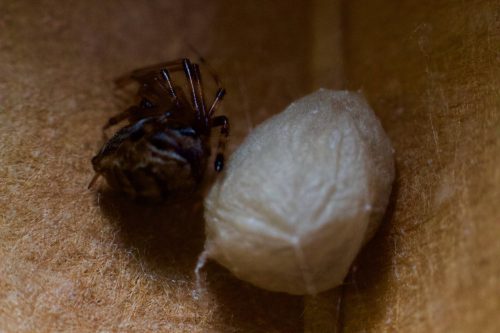I took care of some tedious maintenance work in the lab today — organizing the vials of spiders (lots of them!), double-checking their classification and sex and relabeling them. I color-coded them by species (white is Parasteatoda, green is Steatoda borealis, yellow is Steatoda triangulosa) and made pink and blue stickers for females and males, which tells you the degree of excitement at the lab bench!
But some fun stuff was going on. Remember Brienne, the hugely swollen female that we were sure was going to make an egg sac any day now, and she didn’t, and she kept getting bigger and bigger? She finally got off the pot and laid a big batch of eggs!
Here’s Brienne before:
Here’s Brienne now:
Finally! She hasn’t moved from that corner of her cage, but it’s got to be a relief to expel that load. The egg sac is bigger than she is!
Also, as I was sorting through the spiders, I saw that another egg sac had popped overnight. Here’s a contented female surrounded by her brood in one of our vials:
She’s a nameless P. tep, which seems callous now — we don’t give them names until we move them into the bigger cages, but they’re still quite capable of pumping out eggs in more cramped quarters. Maybe I’ll have to give her a newer, bigger home…and a name. Got any suggestions?





How about naming her “Morag?” It’s a good Scottish name and yet has something that is sort of Middle Earth about it…
OK, so this is me showing my complete ignorance of spider physiology. I am certain that different spiders have different exoskeletons, but something in me is thinking that spiders that small tend to have more rigid exoskeletons. How does her abdomen swell and not crack? Clearly, my understanding is wrong so I’m asking.
I hope you name one Boudicca. And perhaps another Marie Antoinette.
The cuticle has to undergo an enzymatic reaction to become rigid, otherwise the exoskeleton is soft and flexible. After a molt, only certain large areas of armor are hardened; the joints and spaces between the tergites remain flexible.
It’s more like a Roman lorica segmentata than rigid late Medieval plate.
In response to the other naming suggestions: Inanna. And I’m guessing someone else has already mentioned Shelob.
There’s Emmy (for Emmy Nöther), Sophie (Germain), Sofia (Kovalevskaya)…plenty of badass women in science from which to pick names.
Ursula
https://en.wikipedia.org/wiki/Ursula_Franklin
I suppose S[pider][sex][monotonically increasing sequence number] is not on the cards?
(SF31, for example)
John, you’re an incurable romantic.
Many hundreds of spiderlings in the lab. How many will graduate to being named?
If God loves them, all of them.
otherwise …
We have an orb spider in a web in one of the corners of the (outdoor) theatre I am currently working in. The first suggestion to name it was “Charlotte,” but that’s a bit trite. I suggested “Peter” since we couldn’t be certain if it was male or female and then said, “Or Gwen.”
Only a couple got it directly.
Spider-spider!
Spider-spider!
Does whatever a spider does!
Can it swing from a web?
Of course it can! It’s a spider!
Watch out!
Here comes Spider-spider!
Am I assuming correctly that Spidey McSpiderface has been used already?
Oh and if “Shelob” is taken (it must be, just like “Ungoliant”), there is this weird thing that in the German translation, the name morphed to “Kankra”, for reasons unfathomable (just looked it up – the reasons are fathomable after all, it’s a literal German translation of an old English word for spider, “lob”, and the female pronoun “she”).
So, if someone desperately needs more Tolkien in their lab… (hell, I know I do)